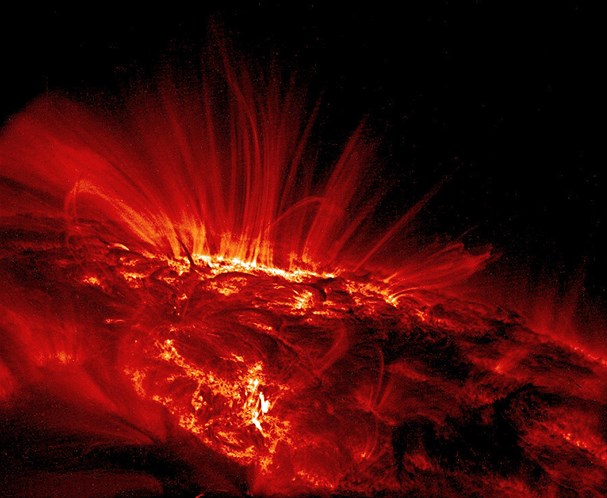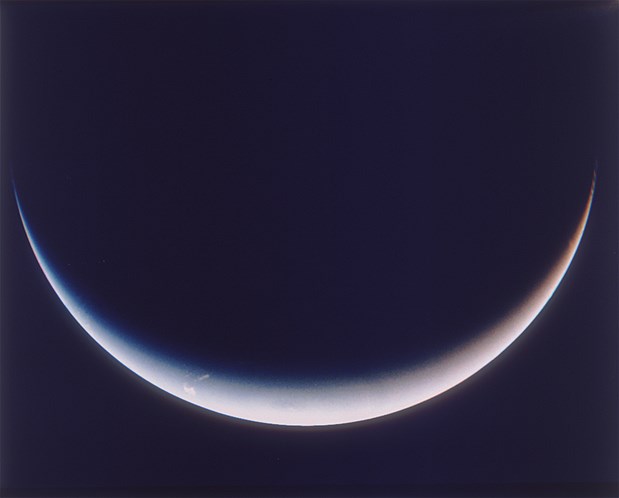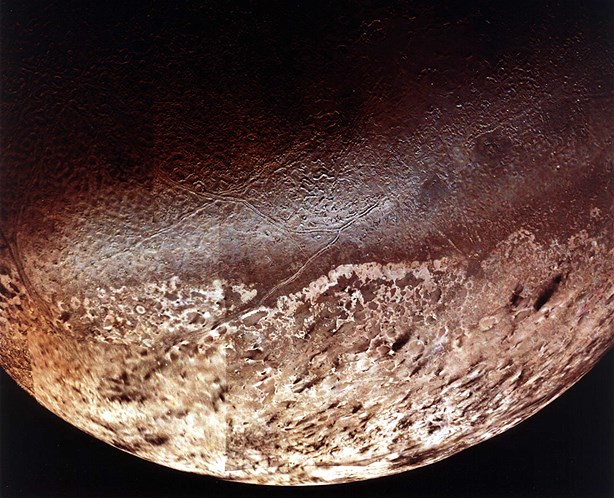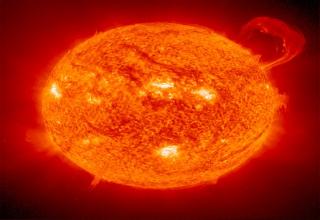Our stunning solar system
Nathan Johnson
Published
08/23/2014
While Mother Earth is a beautiful creature, the solar system surrounding her is equally breathtaking.
- List View
- Player View
- Grid View
Advertisement
-
1.
 This is an Extreme Ultraviolet Imaging Telescope image of a huge, handle-shaped prominence.
This is an Extreme Ultraviolet Imaging Telescope image of a huge, handle-shaped prominence. -
2.
 Emissions peg the upper chromosphere of the Sun at a temperature of about 60,000 degrees K.
Emissions peg the upper chromosphere of the Sun at a temperature of about 60,000 degrees K. -
3.
 The colors of the solar system's innermost planet are enhanced in this view, based on global image data from the Mercury-orbiting MESSENGER spacecraft.
The colors of the solar system's innermost planet are enhanced in this view, based on global image data from the Mercury-orbiting MESSENGER spacecraft. -
4.
 The sprawling Caloris basin on Mercury is one of the solar system's largest impact basins.
The sprawling Caloris basin on Mercury is one of the solar system's largest impact basins. -
5.
 The transit of Venus across the sun.
The transit of Venus across the sun. -
6.
 A computer-enhanced radar image from the probe Magellan shows the surface of Venus with two volcanoes, Gula Mons and Sif Mons.
A computer-enhanced radar image from the probe Magellan shows the surface of Venus with two volcanoes, Gula Mons and Sif Mons. -
7.
 This colorized image of Venus was recorded by the Jupiter-bound Galileo spacecraft shortly after its gravity assist flyby of Venus in February of 1990.
This colorized image of Venus was recorded by the Jupiter-bound Galileo spacecraft shortly after its gravity assist flyby of Venus in February of 1990. -
8.
 Among the views of Earth glimpsed by astronauts aboard the International Space Station ISS, surely one of the most spectacular is of the aurora.
Among the views of Earth glimpsed by astronauts aboard the International Space Station ISS, surely one of the most spectacular is of the aurora. -
9.
 View of Moscow, Russia from the International Space Station.
View of Moscow, Russia from the International Space Station. -
10.
 This true color satellite image of the Earth centred on the Americas shows cloud coverage during winter solstice.
This true color satellite image of the Earth centred on the Americas shows cloud coverage during winter solstice. -
11.
 The city lights of Spain and Portugal define the Iberian Peninsula in this photograph from the International Space Station ISS.
The city lights of Spain and Portugal define the Iberian Peninsula in this photograph from the International Space Station ISS. -
12.
 The bright Sun greets the International Space Station in this scene from the Russian section of the orbital outpost.
The bright Sun greets the International Space Station in this scene from the Russian section of the orbital outpost. -
13.
 This view of the rising Earth greeted the Apollo 11 astronauts as they came from behind the Moon after the lunar orbit insertion burn.
This view of the rising Earth greeted the Apollo 11 astronauts as they came from behind the Moon after the lunar orbit insertion burn. -
14.
 This combination image shows the "Blood Moon" total lunar eclipse as seen over Minnesota.
This combination image shows the "Blood Moon" total lunar eclipse as seen over Minnesota. -
15.
 Comet ISON shines in this five-minute exposure taken at NASA's Marshall Space Flight Center.
Comet ISON shines in this five-minute exposure taken at NASA's Marshall Space Flight Center. -
16.
 Planet Mars.
Planet Mars. -
17.
 This image, taken from the Mars Express Orbiter, shows part of a cratered landscape to the north of the Valles Marineris.
This image, taken from the Mars Express Orbiter, shows part of a cratered landscape to the north of the Valles Marineris. -
18.
 Victoria Crater on Mars as seen from an oblique angle. Mars Rover tracks are still visible just left of the crater.
Victoria Crater on Mars as seen from an oblique angle. Mars Rover tracks are still visible just left of the crater. -
19.
 A portion of the west rim of the Endeavour crater on Mars.
A portion of the west rim of the Endeavour crater on Mars. -
20.
 Mars is the fourth planet in the solar system.
Mars is the fourth planet in the solar system. -
21.
 Twin Peaks on Mars.
Twin Peaks on Mars. -
22.
 An up-close look asteroid Vesta, the brightest asteroid in the solar system and the object which takes up about 10-percent of the entire mass of the main asteroid belt.
An up-close look asteroid Vesta, the brightest asteroid in the solar system and the object which takes up about 10-percent of the entire mass of the main asteroid belt. -
23.
 An artist's concept of dwarf planet Haumea and its moons, Hi'aka and Namaka.
An artist's concept of dwarf planet Haumea and its moons, Hi'aka and Namaka. -
24.
 An artist's rendition of the largest object found orbiting the Sun since Pluto was discovered in 1930. It's called ''Quaoar'' and is roughly 800 miles in diameter and orbits the Sun at a distance of four-billion miles in a region of space called the ''Kuiper Belt.''
An artist's rendition of the largest object found orbiting the Sun since Pluto was discovered in 1930. It's called ''Quaoar'' and is roughly 800 miles in diameter and orbits the Sun at a distance of four-billion miles in a region of space called the ''Kuiper Belt.'' -
25.
 Complex and beautiful patterns adorn the icy surface of Jupiter's moon Europa, as seen in this color image intended to approximate how the satellite might appear to the human eye.
Complex and beautiful patterns adorn the icy surface of Jupiter's moon Europa, as seen in this color image intended to approximate how the satellite might appear to the human eye. -
26.
 This is a montage of New Horizons images of Jupiter and its volcanic moon Io, taken during the spacecrafts Jupiter flyby in early 2007.
This is a montage of New Horizons images of Jupiter and its volcanic moon Io, taken during the spacecrafts Jupiter flyby in early 2007. -
27.
 Jupiter as seen by Voyager 1 at a distance of more than 28.4 million kilometers, or 17.5 million miles. The white moon to the right is Europa, and the red moon to the left is Io.
Jupiter as seen by Voyager 1 at a distance of more than 28.4 million kilometers, or 17.5 million miles. The white moon to the right is Europa, and the red moon to the left is Io. -
28.
 Volcanoes, lava flows and mountains on Jupiter's moon Io. Haemus Mons, a 32,000-foot mountain, is entering the moon's night side on the right.
Volcanoes, lava flows and mountains on Jupiter's moon Io. Haemus Mons, a 32,000-foot mountain, is entering the moon's night side on the right. -
29.
 In the shadow of Saturn, unexpected wonders appear.
In the shadow of Saturn, unexpected wonders appear. -
30.
 Montage of Saturn and six of the planet's moons, created from images taken by Voyager 1 back in November 1980.
Montage of Saturn and six of the planet's moons, created from images taken by Voyager 1 back in November 1980. -
31.
 Colorful Saturn and its rings as photographed by the Cassini spacecraft. The F-ring shepherd moon Pandora is faintly visible at the top, left of center.
Colorful Saturn and its rings as photographed by the Cassini spacecraft. The F-ring shepherd moon Pandora is faintly visible at the top, left of center. -
32.
 Uranus is the seventh planet in the solar system and, like Saturn, has a ring system.
Uranus is the seventh planet in the solar system and, like Saturn, has a ring system. -
33.
 An image of Uranus taken by Voyager 2 as it passed the giant planet. Visible are Uranus' 18 moons, a number that ties it with Saturn for the most around any planet.
An image of Uranus taken by Voyager 2 as it passed the giant planet. Visible are Uranus' 18 moons, a number that ties it with Saturn for the most around any planet. -
34.
 Uranus and its five major moons are depicted in this montage of images acquired by the Voyager 2 spacecraft.
Uranus and its five major moons are depicted in this montage of images acquired by the Voyager 2 spacecraft. -
35.
 The south pole of the planet Neptune, as seen by the Voyager 2 spacecraft in August 1989.
The south pole of the planet Neptune, as seen by the Voyager 2 spacecraft in August 1989. -
36.
 This photo of Neptune's satellite moon Triton was taken in 1989 by the only spacecraft ever to pass Triton: Voyager 2.
This photo of Neptune's satellite moon Triton was taken in 1989 by the only spacecraft ever to pass Triton: Voyager 2. -
37.
 This is Neptune, the fourth largest planet in our solar system.
This is Neptune, the fourth largest planet in our solar system. -
38.
 This picture shows the Great Dark Spot of Neptune and its companion bright smudge.
This picture shows the Great Dark Spot of Neptune and its companion bright smudge. -
39.
 This artist's concept shows the Pluto system from the surface of one of the candidate moons.
This artist's concept shows the Pluto system from the surface of one of the candidate moons.
This is an Extreme Ultraviolet Imaging Telescope image of a huge, handle-shaped prominence.
39/39
1/39









2 Comments